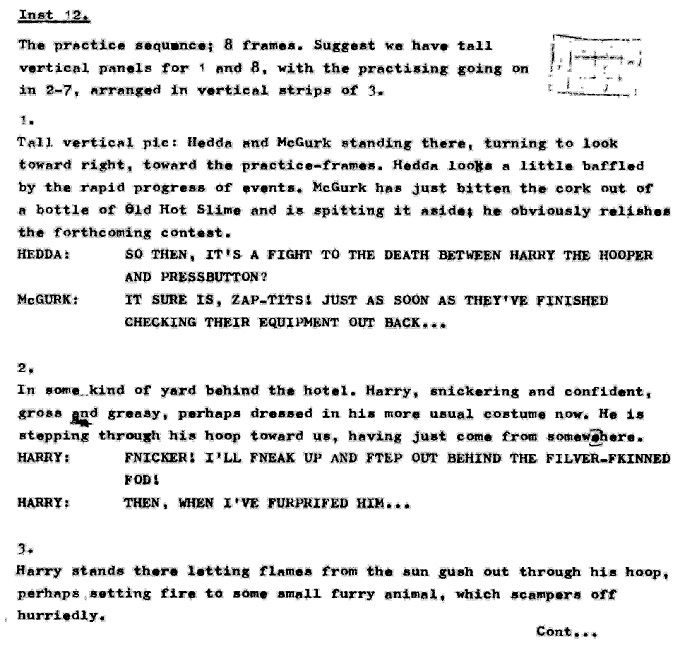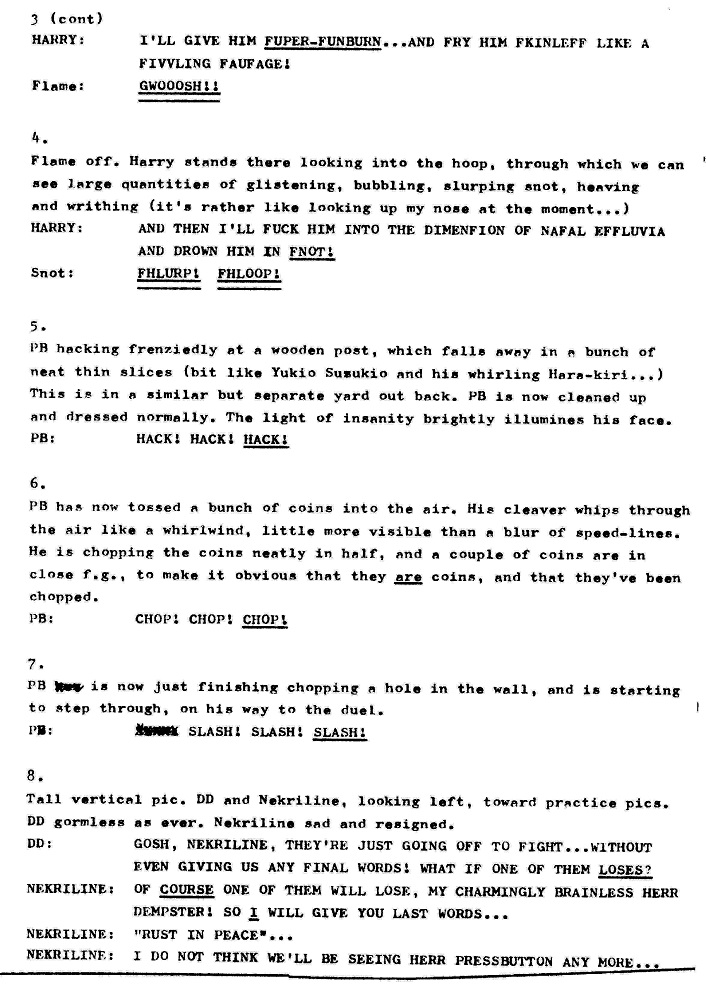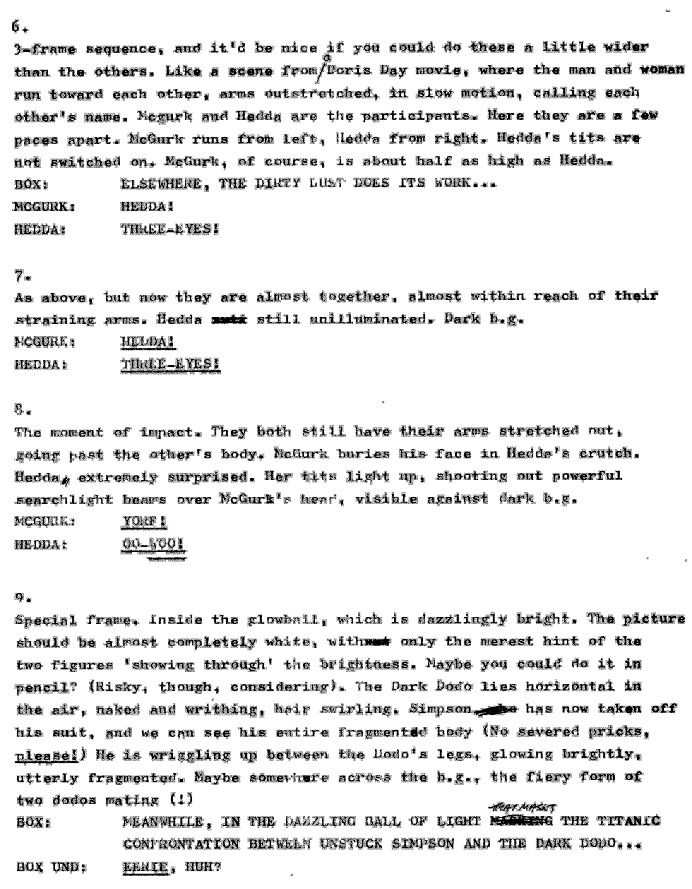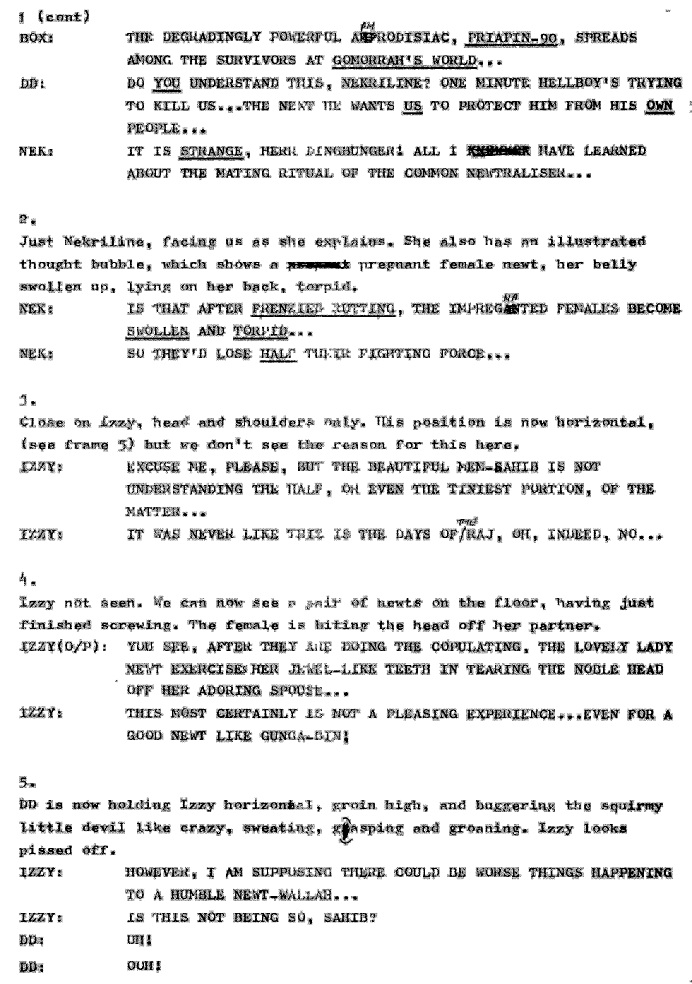Here’s the sixth part of my interview with the late Steve Moore, with more to follow. The 1st, 2nd, 3rd, 4th, and 5th parts are already online, along with some explanation of how the interview came about.
One note on the text, which is particularly relevant in this section, so worth repeating: As we went along, I would ask supplementary questions, which got inserted into the previous text. To make it clear where a question has been added in later, I’ve included little arrows for those subsidiary questions, like this: ->. Occasionally, there were further questions, which are indicated by an ever expanding length of arrow, like this –> or this —>. Hopefully this will help to understand how the interview unfolded. So…
PÓM: You were a young man in a very vibrant and modern London, at that time. Did you have any interaction with the kind of things we hear about it, like the emerging drug culture?
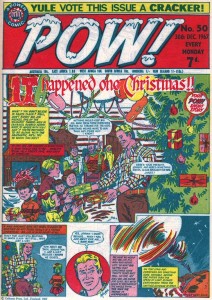
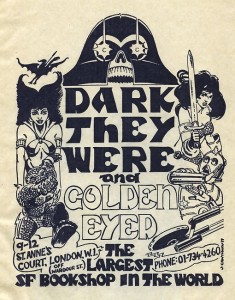
Hashish was something I mainly indulged in when it was easily available, as it was at Bookends and during the time I worked at and hung out at DTWAGE, especially in the final years in St. Anne’s Court, when it was delivered by motorcycle courier. Otherwise, friends would get it for me when they got theirs; I had very little contact with actual dealers. So a lot of my work in the first period of my comic career, from 1972 to the late 1980s, was written on dope; I seem to recall this was particularly the case on Warrior. These days I can’t work on it at all, but since I gave up smoking I’ve had to eat it, and that can have a tendency to just wipe out all inclination to work anyway. Especially the way I tend to overdo it.
There were psychedelics around in the late 1960s and early 1970s as well, of course, though I tended to be a bit timid about those. Where friends would say ‘I’m taking two (or three) tabs of acid!’ I’d tend to say ‘I think I’ll stick to one.’ As a result I rarely got completely blitzed, though I had some interesting experiences; but I think I liked to stay in control a bit too much (though that hasn’t stopped me, on occasion, eating so much hashish I passed out, or laughed so much I went into cataplectic fits). There were a few LSD trips, a couple with mescaline (if that was, in fact, what was in the tablet it was sold as) and rather more with psylocybin mushrooms, which are probably my favourite psychedelic, though I hardly ever indulge these days.
When things got tough at Bookends, toward the end, we resorted to amphetamines for a while, to get the work done, which isn’t at all a good idea; and, being available during the late 1970s when I was hanging out at DTWAGE, I indulged again for a little while (though never since). If someone offered me a free line of cocaine I wouldn’t say no, and I smoked opium once or twice, but it only put me to sleep and didn’t do anything. Heroin and barbiturates I stayed well away from, though, as I could see the damage they were doing to people I knew. So it’s really mainly been hashish. 
And if you ask: ‘can drugs increase creativity?’ I’d probably say, on balance, that for me, they probably haven’t, though I know some people would have a different view; but they probably haven’t decreased it, either. I neither advocate nor oppose them. When they were there, I took them; when they weren’t, I got on without them. That’s life…
PÓM: You mentioned you thought some of the Chinese clubs might have been run by Triads. Did you have any proof of this, or indeed any contact with the Triads, as you became more immersed in Chinese culture?
SM: No, I can’t prove they were run by Triads, though I rather suspect it. The best I can say is that this is what’s known as ‘informed speculation’. But it turned out that my friend, the young kid who’d been working as a projectionist and letting me in to the movies for free, quite separately managed to get involved with the Triads, and not in a very pleasant way.
For reasons that will soon become apparent, I’m going to call him ‘Chang’, though that wasn’t his real name. Well, by the end of the 1970s, the cinema clubs were starting to close down, to be replaced by Chinatown video hire shops, which meant that I lost touch with my beloved Chinese movies until the advent of the home video market in the mid-1980s. It also meant that Chang lost his job. By then he was in his early 20s and married to a Chinese immigrant who’d illegally entered Hong Kong, and they had a baby, so without the projectionist job he then started working in a takeaway restaurant in Watford. When he was back in London, I’d occasionally meet him for lunch, often accompanied by his equally young Scottish friend ‘Peter’ (again, not his real name), who seemed nice enough. And then the lunches stopped, and we just sort of drifted apart.
Then a couple of years later, in the early 1980s, Chang suddenly turned up on my doorstep (I think on a Saturday morning), in something of a state, which I eventually realised was fear. So I got him on his own (my mother and brother were still here) and a rather complex story came out. It seemed that, like many Chinese, Chang was fond of gambling, and he told me he’d borrowed £500 from a Triad loan-shark to get himself a stake. Obviously, that was worth rather more back in those days than it would be now. I think Chang had been mainly gambling on arcade gaming-machines in Soho but, unsurprisingly, he’d lost all the money. I don’t know what the interest would have been – probably something like 10% a week – but now the Triads wanted their money back, and they meant ‘now’, not ‘soon’. So he was sleeping in his car and hoping they wouldn’t find him.
Chang, however, had a novel solution in mind, involving Peter – of whom, it seemed, I’d gained a rather mistaken impression. Instead of being the innocent young kid I thought, it turned out he was actually both gay (I hadn’t realised) and an armed robber, who sometime previously had attempted to mug a pensioner at Waterloo. Things went wrong, however, when the pensioner not only fought back, but started chasing him as well, at which point Peter turned round and shot the man in the head, leaving him in a vegetative state. He then fled to Thailand with his Thai boyfriend, and I think was about to return now that the heat had died down a bit.
So Chang’s plan was to turn Peter in for the £1500 reward that had been offered, and use the money to pay off his Triad creditor. The only problem with this plan was that the reward wouldn’t be paid out until a conviction was obtained, so he wanted to stay with me in the meantime, in the hope that the Triads wouldn’t look for him here.
I still have very mixed feelings about my reaction to this (I’m not sure it was my finest hour), but I’d had a fairly sheltered upbringing with no direct contact with the underworld, and I really didn’t want my aged mother opening the door to a bunch of armed Triad thugs if they turned up looking for Chang. Or my brother or myself, come to that. I asked Chang if there was anywhere else he could go, and he said he knew someone in Manchester (which itself was a Triad hotbed, so I’m not sure this was the best option). So I gave him a blanket and all the money I had in my wallet, which I think was about £70, and off he went. I never heard from him again, so I don’t know what happened about the plan to shop Peter to the police, or whether Chang sorted out his differences with the Triads. But I find it very difficult to think of a particularly positive ending to the story. Perhaps it’s better not to know…
So that’s as close as I got to the Triads and, frankly, even that was rather closer than I wanted to get. But I still sorta hope that Chang managed to get out of that scrape … somehow …
PÓM: What sort of amount of work were you producing at that time?
SM: I’ve a feeling things may have been a bit slack around 1975/76, and that may have been the period when for a few months I worked a couple of days a week at DTWAGE. Each year I had the annuals to carry me through from about September to February, and on average there’d be four or five books to work on. I also know I did a few projects that never saw publication – I particularly remember doing a comic-strip adaptation of Stevenson’s Treasure Island for someone (which was the first time I’d actually read the book, and I found it far more enjoyable than I’d expected), but it never appeared. That may have been around this time. And it was probably around then that I was writing the movie scripts. But work started to pick up with House of Hammer, and then at the beginning of 1977 there was 2000 AD and in 1978 Hulk Comic, followed by Dr Who and Warrior. So the end of the ’70s and the beginning of the ’80s was one of my busiest periods of comic-book writing. I never made a fortune and (as I may have said earlier), if I’d had a mortgage to pay and a family to support I would have been in some difficulty. But I had enough to buy books, which has always been my first priority!
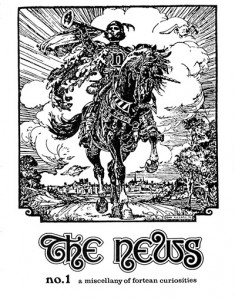
PÓM: Did you do any work for Dez Skinn while he was in charge of Marvel UK?
SM: Yes, quite a bit. Dez moved to Marvel UK shortly after HoH folded, and started Hulk Comic at the beginning of 1979. The first issue came out in March, so there would have been a bit of lead-time before then when we were working on this. Dez had the idea that we should do original material featuring Marvel heroes, but tailored for the British market, and I think this was around the time of the Hulk TV series with Lou Ferrigno. This was alongside the reprint material as well, so I think the early issues actually had two Hulk strips in each issue, one reprint, one original. I’m pretty sure I wrote at least some of the Hulk stories, though I can’t remember if I wrote all the original stories or shared them with Steve Parkhouse. The main thing I wrote for this, though, was Nick Fury, which I think ran for the first 19 issues. This was drawn by Steve Dillon, who was about 16 at the time, and it may well have been his first strip. I don’t think I actually met Steve when we were doing this. It was still the time when for the most part a writer would have no idea of who’d be drawing his script, and no contact with the artist; a situation that I think only really started to change when Warrior began, at which point I worked very closely with Steve.
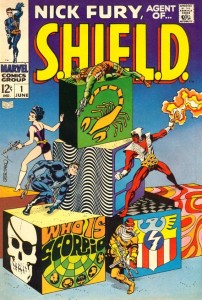
Eventually the original strips were dropped, presumably because they were less economical than the reprints. And, of course, by then we were starting work on Dr Who Weekly, the first issue of which appeared in October 1979. So I just moved from one to the other, and kept on working for Dez.
PÓM: How aware were you of what else was going on in the UK comics business at that time? Pat Mills and the like seemed in particular to be trying to push what they could get away with.
SM: I was hardly aware of anything at all except what I was working on. Since I’d gone freelance I wasn’t really reading comics for pleasure and no longer considered myself a fan, and I’d never even heard of Pat Mills before 2000 AD. I’d really kept away from IPC, once I’d dropped writing the odd Slowcoach story for Whizzer and Chips (okay, apart from Mirabelle!) as I didn’t like their editorial attitudes when it came to handling scripts, and I much preferred to work for relatively smaller companies, rather than a big corporation like IPC, with its corporate attitudes. I gather that Pat was doing some fairly progressive stuff on Action and Battle, but Battle was a war comic, which of course was revolting to me, so I wouldn’t have gone anywhere near it. And, besides, I really hadn’t envisaged working for IPC again until 2000 AD came along, which only interested me because it was an SF comic.
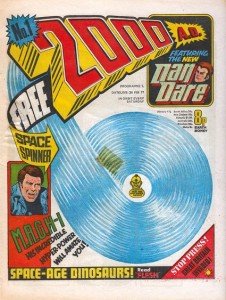
SM: It was basically just 2000 AD, though before we talk about that I’d just like to briefly mention the short-lived comic Tornado as it’s a good illustration of my relationship with IPC. Tornado was a mixed action and adventure comic that started in 1979, under the editorship of Kelvin Gosnell, and only lasted 22 issues. I was already working for 2000 AD by this time, and Kelvin asked me to contribute a short strip starting in Tornado’s first issue. He may actually have asked me for a historical story, but anyway I persuaded him to take a three-issue series, which was a true story about the Japanese warrior-monk, Benkei, who lived in the 12th century and was eventually killed by his enemies. There was enough adventure in his life for me to make a decent little three-part series, but I was basically writing a historical biography of a real person, ending with his heroic death. When the comic eventually appeared I found they’d altered the ending into something much more optimistic. I haven’t got a copy to hand, but I seem to remember they’d changed it so that Benkei actually escaped his enemies and ‘became a legend’. This they’d done without consulting me, and they’d put my name on the strip, which, to anyone who knew about Benkei, would have made me look a complete idiot. I was so annoyed I never worked for Tornado again.
I can’t remember exactly how I got involved with 2000 AD. I think I must have heard about it over the grapevine from someone, and it was an SF comic so I got in touch with them, rather than them approaching me. I think at the time my only other work was House of Hammer and the annuals, so I was looking for a bit of extra work. But I never actually felt comfortable working for it, for a number of reasons. One of them was the thing I just mentioned about IPC being a large corporation, and whereas I always felt with a smaller company that I was working with the editor as a collaborator, with IPC I always felt I was working for them, as a hired hand. Successive editors of 2000 AD have always given me the impression that they thought it was an enormous privilege to work for it, and that I should be grateful – presumably because they always had lots of other people wanting to get in on the act. The only editor who I actually felt made me welcome was Andy Diggle, when I returned to work for the title in 2000. I also used to feel that the editors and contributors formed a sort of clique that went to conventions and on signing tours together, and from what I hear a lot of them are heavy drinkers. As I’m not a drinker and can think of nothing more ghastly than spending an evening with a bunch of drunks talking about comics, I never really penetrated the clique, and always felt something of an outsider. And lastly, of course, I don’t actually like the comic that much.
I always thought Judge Dredd was utterly loathsome (though I did write one short strip for an annual). I appreciate that it was often beautifully drawn and that John Wagner’s a good writer, and I’m also told that it’s supposed to be satirical on occasion, but it espouses execution without trial and is basically about a personality-free fascist who I find about as entertaining as that hilarious Mister Hitler. 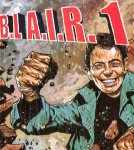
But work was work and, besides, at the beginning I didn’t really know what direction the comic would be going. I was well-established enough by that time for them to offer me the second story-arc on the revamped Dan Dare, which I think ran from about issue 12 to 20, or something like that, and was drawn by Bellardinelli, an artist who didn’t appeal to me much at all. All I can remember about the story is that the villain had two heads, which argued with each other. I didn’t much like the new Dan Dare, and maybe it showed, because they didn’t offer me another series on it.

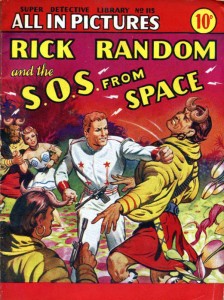
PÓM: I know that yourself and Alan Moore are friends, and have worked together on many things over the years. Do you remember how the pair of you first got in touch with one another, and when you first met?
SM: This is a bit vague, but Alan and I spoke about this recently and I think we’ve got it sorted out. Before organising the first UK Comic Convention, Phil Clarke put out a sales list called The Comic Fan (this is to be distinguished from The Comic Fan Special, which was the bulletin of the Convention), and I printed the lists off for him on my duplicator. In the second issue, as well as advertising Ka-Pow #1, there was an advert from me, because, being besotted with the TV Avengers at the time, I was looking for a novelisation called Dead or Alive. Alan saw those ads, wrote to me, and so the correspondence started.
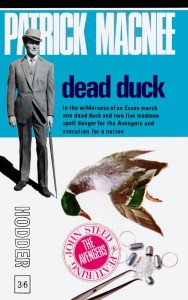
After that, Alan seems to think that we first met face-to-face at the second Con in 1969. I’ve a notion, though, that we first met on a day-trip he made to London with his parents. I met them in town (where they presumably got the chance to check me out and see that I was, in fact, at least basically human) and then brought Alan back to my house for the afternoon before returning him, apparently undamaged, to the loving arms of his family. But exactly when that trip was (i.e., either before or after the 1969 Con) may be open to dispute. I think it was before. Actually, considering how important that first contact turned out to be for both our lives, it’s surprising how fuzzy the whole thing is. Maybe the Martians have tampered with our memories. Or, more likely, it’s the drugs.
Either way, the tradition we’ve always maintained is that we’ve known each other since I was 18 and he was 14. Going by our respective birthdays, that would mean we’d have to have first got in touch by letter sometime between November 1967 and June 1968, which seems to fit with his being a non-attending member of the 1968 Con. Whenever it was, I think one of the things that drew us together initially was the coincidence of our surnames, absurd though that may seem. Of course, in the decades since I’ve seen myself referred to as ‘no relation’ so many times I rather feel they’ll put it on my tombstone, and it was with considerable glee that when we got to preparing the back-flap biographies of Somnium I was able to describe him as ‘Alan Moore (no relation)’!
Anyway, Alan used to send me entertaining letters decorated with little drawings of ‘The Avenging Hunchback’ (sole line of dialogue: ‘Glerk!’) and before too long we were seeing each other quite frequently. And taking drugs together, of course. Apparently, Alan decided that if I was smoking dope it must be okay for him to do so too (I don’t think his mum ever forgave me, especially after he was expelled from school).
->PÓM: Have you kept any of those letters? And, if so, how likely is it you can scan them for the rest of the world to see?
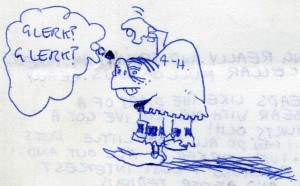
PÓM: I have this romantic scenario in my head where Alan is the wild one, always leading you astray, whilst you are the quiet one, being dragged into all sorts of wild scrapes by your friend. But this is really entirely wrong, isn’t it, as regards comics, drugs, and magic? You are quite literally the man who led Alan Moore astray.
SM: Well, I’d like to portray myself as an evil Svengali who took one look at Alan and realised that here was a striking-looking but malleable individual who I could get years of pleasure destroying an inch at a time, but it wasn’t really like that … even if he has said publicly that I was the man who ruined his life! I just wander into these things like writing comics, smoking dope, practicing magic and resigning on points of principle, and the next thing I know Alan’s decided that as I haven’t actually died as a result, he’ll do the same … only he does it much larger. It’s not my fault, honest! Mind you, he doesn’t always follow my lead. I’ve never got him hooked on China or classical music, in the same way that I’ve never really shared his interest in science or stand-up comedy. We just have areas of interest that overlap … and enormous mutual respect in areas where they don’t. And even where they don’t, there’s still a bit of influence going back and forth.<-
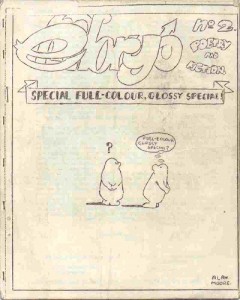
There was a time in the mid-1970s when we didn’t see each other quite so often (perhaps twice a year) mainly, I think, because Alan was busy getting married, having kids, holding down a ‘proper job’, etc. And then one day he showed up and showed me a drawing he’d done (I’ve a feeling it may have been some sort of fantasy scene with a sailing ship) and told me he wanted to get back into drawing again. And that really kicked off the second phase of our friendship, which has lasted to this day.
->PÓM: Probably a colossally stupid question, but what was Alan Moore like? What were your first impressions of him, do you remember? What appealed to you about him?
SM: You have to remember that our friendship was first established by letter, and the ones he wrote were always entertaining, funny and a bit mad. When I actually met him he was still very young, with a thick mop of hair that hadn’t yet grown long, no beard and a slightly chubby face. And he was fun. He had a great sense of humour, he was affable, honest, generous, straightforward, interesting and interested in everything, and far more sociable than I ever was. We just took to each other and haven’t been able to get rid of each other ever since.<- PÓM: Comics legend has it that you taught Alan how to write a comic script. Do you remember this, and what advice you gave him?
SM: It’s a story that Alan has very kindly promoted himself, as well, though I’m not sure what I did really justifies it. As I’m sure you know, at the start of his career in the late 1970s Alan saw himself more as a cartoonist, and was quite capable of writing his own stories when he was just presenting a finished page of artwork. But when he decided to write serious strips for other artists to draw (and editors to read), he wanted a little advice on how to present things. So I basically just showed him some of my scripts, and how they were laid out, etc., which was very much in the British professional tradition of the ‘full script’, as I’d picked it up from people like Ken Mennell and Tom Tully, with several lines of description for each frame (I still think of the pictures in terms of the British ‘frame’, rather than the American ‘panel’).
And he sent me his first couple of scripts to look at, on which I scribbled a few comments (not with the blue pencil that editors usually used, but with a red pen so I looked far more outraged!) … mainly about things like the usual beginner’s mistakes of using too many words … and that was about it. All the rest of it was Alan’s talent. And I should, perhaps, point out that a couple of other people later asked me ‘how to write a comic-strip’; but none of them actually ‘got it’ in the same way that Alan did.
Having said that much, though, I have to add that I’ve also learned an awful lot about technique from Alan over the years. Of course, back then we were writing very basic scripts, and such things as the immensely long frame description was something he developed on his own. Later, especially in my ‘second period’ in comics after 2000, I also wrote pretty long descriptions, and that’s an example of the reverse influence. I think we really started to get interested in technical discussions about the time of Warrior, and from there it just went on. Even when I’d left the comics field for a few years in the 1990s to write and edit non-fiction, we’d still spend weekends together talking about writing technique, in various media. Mind you, Alan was always more interested in technique than I was; I tended to have a more instinctive approach, which has also been the case with things like magic. I think it’s just a basic difference in temperament.
As for why Alan reversed the usual format where frame descriptions were written in lower case and dialogue in upper case, to write his descriptions in upper and his dialogue in lower, I’ve really got no idea. I tend to look at things like that and think ‘Oh, it’s just Alan …’
PÓM: You got him some of his earliest work, like the stories he did in Marvel UK’s Dr Who comics, I believe?
SM: Obviously, Alan got the vast proportion of his early work on his own. For example, Sounds and 2000 AD he approached entirely by himself. As for Dr Who, which was a little later, that came about because I was switching from the back-up stories to the lead strip, so a new writer was needed for the back-ups. I think by then Alan had made a few sales and wasn’t a complete beginner, so I felt confident enough to recommend him as a replacement. There wasn’t anything special about this. It was just the sort of thing you’d do for a friend, and it certainly didn’t take any work away from me, so everybody won out. I don’t really remember anything else, script-wise, in the very early days. There may have been one or two other things, but my attitude was basically just that if I couldn’t or didn’t want to handle anything, Alan might as well be offered it.
Before that, though, Alan was still thinking of a cartoonist’s career, and what he mainly wanted was exposure, so he was quite prepared to do stuff for free. Steve Burgess, one of the editors of Dark Star (a magazine about West Coast rock music), worked at DTWAGE, so I knew him quite well; and they occasionally ran one-page underground strips, so I made the connection for Alan. I put him forward for some cartoons for the BJ and the Bear Annual, and I think I suggested him for a spread in the Frantic Winter Special that Marvel did in 1979. The last two, he actually got paid for!
PÓM: Just to clarify on the reference to the BJ and the Bear Annual, is it that Alan only drew the cartoons, to accompany your text? Currently, his bibliographies have his as doing both, for want of clearer information. So you’ll be doing the world of Moore scholarship in general a service by clarifying this! [It’s all here, if you’re interested – PÓM]
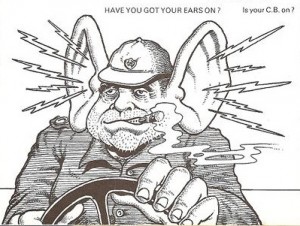
PÓM: You worked together on a few strips, starting with Three Eyes McGurk and his Death Planet Commandos. How did that come about?
SM: Actually, the first thing we worked on together was a half-page strip called ‘Talcum Power’ (not ‘Powder’, as it seems to be referred to occasionally), for Dark Star #21 (July 1979). Alan had produced a full page ‘Avenging Hunchback’ strip for #19, which was pretty much a parody of the Superman origin story, and also drawn a second instalment for #20, but the artwork was stolen before it could be printed. So as a replacement for that he then did a half-page ‘Kultural Krime Komix’ in which he committed suicide over the theft, and that was pretty much the end of the Hunchback.
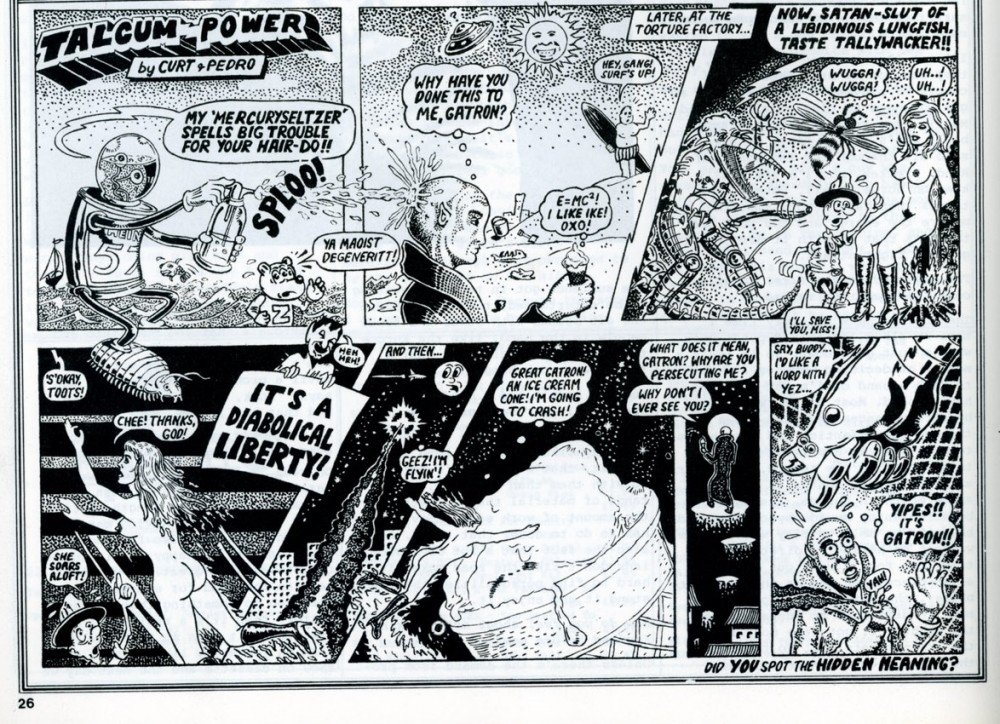
Just as an aside, at around this time Alan was also drawing ‘St. Pancras Panda’ for the Oxford underground magazine, The Backstreet Bugle, and I did actually draw (all on my own!) a half-page silent strip for them called ‘Foobl’, in which an ancient city is attacked by a biplane (again, the meaning probably wasn’t apparent). That appeared in Bugle #30, August 1979, again as by ‘Pedro’. Later, in the first episode of ‘Abslom Daak: Dalek-Killer’ for Dr Who, I included a passing reference to a character called ‘C. Henry Foobl’ (derived from Curt Vile, Pedro Henry and Foobl), which was pretty much the sort of in-joke we used to indulge in back then … and later Alan actually used the character in ‘The Stars my Degradation’.
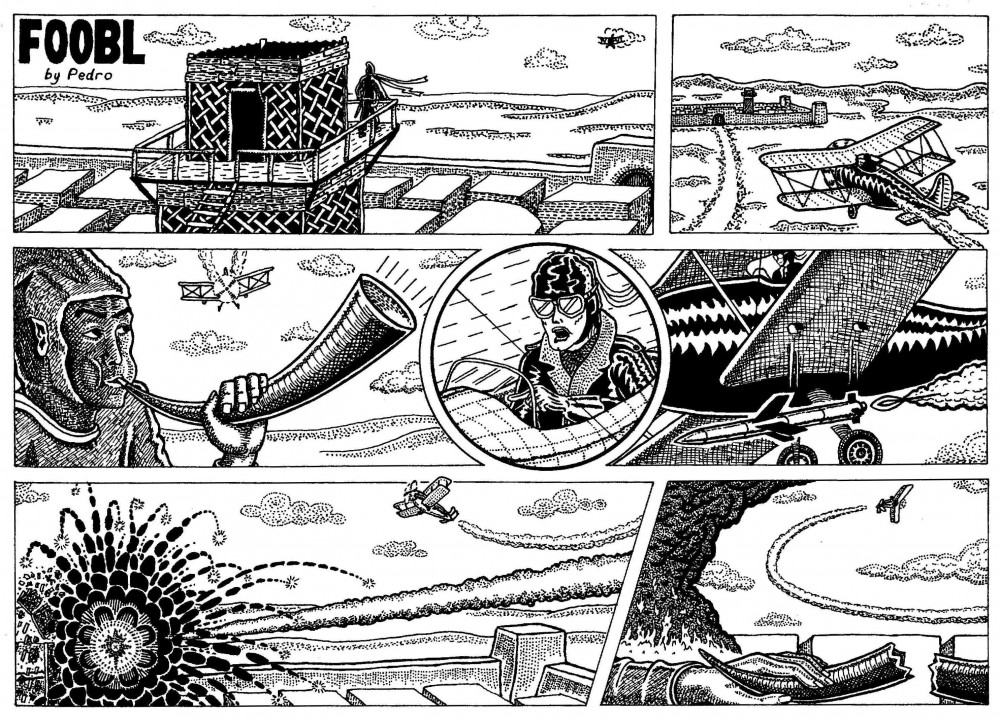
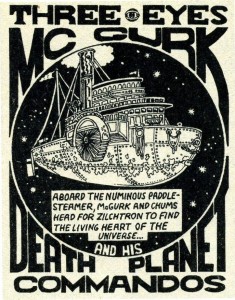
‘McGurk’ saw the first appearance of Pressbutton, a character I’d first come up with in late 1977, and I still actually have the original notebook in which he was first scribbled down:
Character called ‘Press-button’ – he caught Vegan Green Rot years ago, and his body had to be rebuilt from the feet up to above his hips – at the same time they built a button into his chest which, when pressed, give [sic] direct electrical stimulation of the pleasure centres of his brain.
Thus he chats up broads (in bars): “Wanna press my button, honey?”
Thus he is shot to death ‘right on the button’ and dies a happy man – his chest shattered & a hideous grin on his face.
And his companions:
‘Three-Eyes McGurk’
‘Lonesome Henry, the Human Bomb’
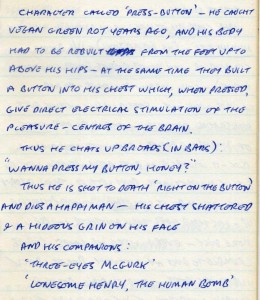
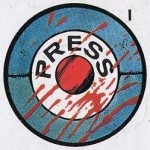
PÓM: I know Pressbutton turned up in Alan’s The Stars my Degradation strip in Sounds, which you took over writing for him a bit over halfway through its run. What I don’t remember is if he appeared before or after you were writing. So, can you set me straight, and tell me how you ended up taking over the writing of the strip?
SM: What happened was that by the summer of 1980, Alan was winding down his Roscoe Moscow strip, and decided he was going to do The Stars my Degradation, a story pretty much set in the same world as Three-Eyes McGurk (so I guess he must have enjoyed his stint on that … we were actually still drawing McGurk at the time). This sounded good to me, and then a couple of weeks later he phoned me up and asked if he could use Pressbutton in the strip. Well, I wasn’t envisaging using Pressbutton again (he was dead, after all, and I didn’t imagine I’d do any more underground strips) so I said of course he could, and he could use McGurk and any of the other material that he wanted as well. This obviously meant that the Stars material was placed earlier in Pressbutton’s life, and when we eventually did the ‘straight’ version in Warrior, that was set earlier still … so he kind of lived his life backwards. Pressbutton first appeared in the fifth instalment of Stars, and it was Alan who gave him the forename ‘Axel’ … I’d never even thought about a forename for him before that.

->PÓM: I note that you’re also doing this interview in sets of questions, rather than one question at a time. So, is this the way you like to work, doing things in lots, rather than a piece at a time?
SM: Umm … I’m making this up as I go along, Pádraig! I’ll do it any way it comes!<- SM: Alan had given me a very rough idea of where he imagined the story-arc going, which was pretty much a ‘back-of-an-envelope’ size synopsis, and after that I just let myself loose and tried to make it as crazy as possible. One of the things Alan had been doing with earlier episodes of the strip was parodying things like The X-Men … but I’m really not interested in parody, so I wanted to make it more of a comedy-adventure in the style of McGurk. And once again, I was challenging Alan to draw all kinds of weird shit, like rubber Episcopalians and battles between newts and Amazons and, of course, the Immolato Tomato … so I was having lots and lots of fun and Alan was probably starting to think this was a really bad idea. And we were trying to get away with as much as we could, of course, which meant the strip was frequently censored, sometimes quite crudely, with whole frames deleted, which we weren’t very pleased about.
->PÓM: What sort of things were they censoring the strips for? I’d have though that the editorial imperatives at Sounds at that time would have been quite relaxed.
SM: We just had too much sexual content for them. Alan had something of a tendency to draw penises everywhere, which usually ended up with ‘censored’ labels stuck over them, and they were obviously less interested in showing acts of sexual congress than we were. There was one occasion where Alan had decided to render the episode in pencil and they simply rubbed out a scene they didn’t like. I should point out that this had been going on before I started writing the strip as well, but I admit it got worse when I took over … but when the story moved to ‘Gomorrah’s World’, on the planet Depravity, what can one expect?<- SM: Sounds also managed to lose one entire episode, though as this was only about Pressbutton and Harry the Hooper practising before their final showdown, probably no one noticed … except me, and I still had the script, of course.
->PÓM: Are we likely to ever see the script for that episode that Sounds lost? And is there any chance Alan could be talked into drawing it?
SM: I’ve scanned the script, and also the full script for an episode where they deleted a couple of frames entirely. The reason the scans start part way down the page is because I was writing these in batches, rather than starting a new script on a new page. We’ve no objection to these scripts being put online, but I think I can say that the chances of Alan drawing the missing script are pretty close to absolute zero.<- [Sorry for the quality of these, folks, but this as good as I have them, I’m afraid.]
PÓM: But you were just scripting now, rather than contributing to the art?
SM: The only other art involvement I had was with the special ‘Christmas on Depravity’ story that we did in December 1981, which was just before I took over scripting the strip. The script was mainly by Alan, though we’d discussed the story when he’d been down to visit previously, and there are one or two of my gags in there. It was also the one that ‘reunited’ Axel and Mysta Mystralis, even though they hadn’t actually appeared in Warrior by this point.
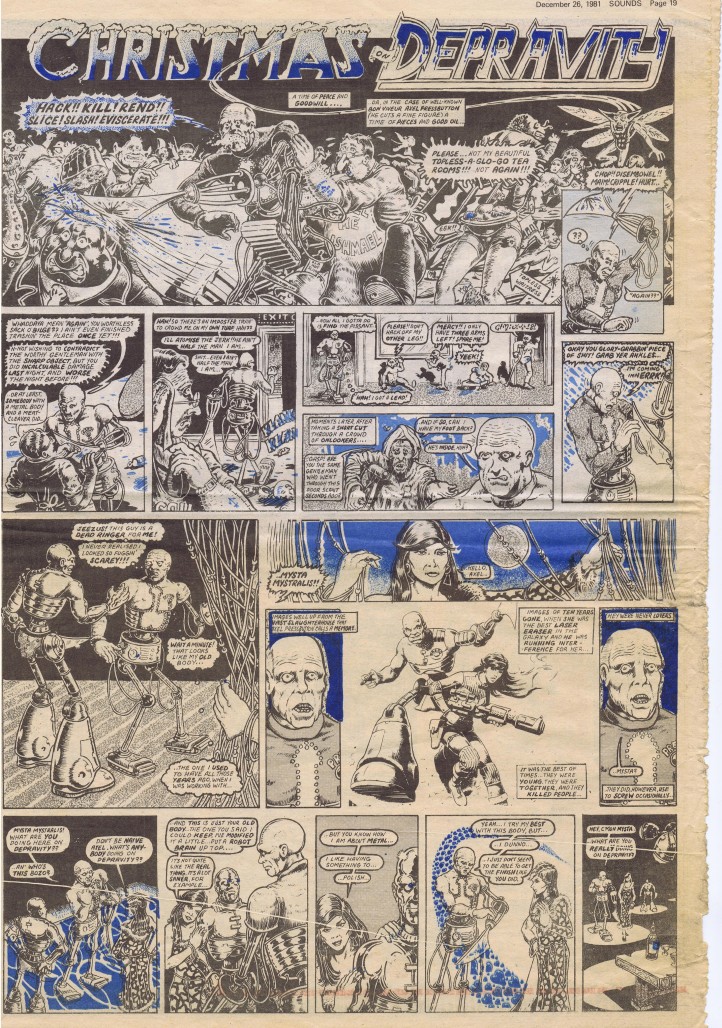
->PÓM: You did at one stage interview yourself in the guise of Pedro Henry, for Warrior. How did that come about?
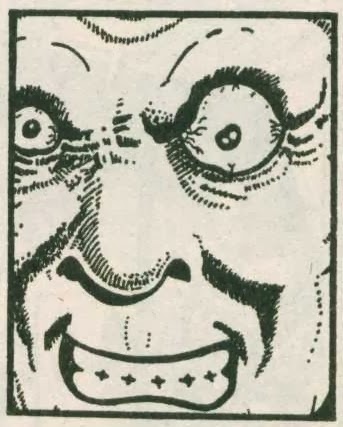
SM: In a way, I guess he does. Apart from those couple of occasions when I was using ‘Pedro’ as an illustrator’s name, I’ve really only used ‘Pedro Henry’ about four times, and three of them have been related to Pressbutton: ‘Three-Eyes McGurk’, ‘The Stars my Degradation’, ‘Laser-Eraser & Pressbutton’, and a strip called ‘The Bug Hunters’ that I did with Jerry Paris in the 1980s. The common factors among them are basically that they’re all SF strips, and that they’re all pretty bonkers! I think, particularly by the time I’d got to the third of these, that ‘Pedro Henry’ had largely developed a style of storytelling that was pretty much ‘his own’, and one that was far madder than the Steve Moore who was writing, say, ‘Shandor’ or ‘Dr Who’. And, of course, that meant that Pedro was ‘expected’ to write in his own particular way. In a way, that meant that when I was writing as Pedro, it was a way of letting myself off the hook and being as outrageous as I liked. Everyone expected Pedro to write like a swivel-eyed lunatic, so naturally he did. I rather miss the old fella …


